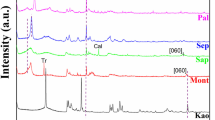Abstract
When aqueous dispersions of Na+-smectite or n-butylammonium-vermiculite react with sulfate salts of Fe(II), Co(II), or Ni(II) bipyridyl or 1, 10-phenanthroline complexes in excess of the cation-exchange capacities, intersalated phases with spacings of about 29.5 Å are obtained. Thermal decomposition of the intersalated complex cations affords expanded phases with a d(001) spacing near 18 Å for the smectites and near 28 Å for the vermiculites. These phases are stable to temperatures of at least 550°C. Nitrogen surface areas of the fired products are as high as 400 m2/g.
Резюме
Когда водные дисперсии Na+-смектита или n-бутил-аммониевого вермикулита реагируют с сульфатными солями Fe(II), Со(ІІ), или Ni(ІІ)-бипиридиловыми, или 1,10-фенантролиновыми комплексами сверх катионных обменных способностей, образуются межсолевые фазы с промежутками около 29,5 Å. В результате термальной декомпозиции катионов межсолевого комплекса образуются расширенные фазы с промежутками d (001) около 18 Å для смектитов и около 28 Å для вермикулитов. Эти фазы стабильны к температуре по крайней мере до 550°С. Азотные поверхностные площади прокаленных продуктов достигают 400 м2/г.
Resümee
Wenn wäßrige Dispersionen von Na+-Smektit oder n-Butylammonium-Vermiculit mit Sulfaten von Fe(II), Co(II), oder Ni(II) bipyridyl oder 1,10-Phenanthroiinkompiexen über die Kationenaustauschkapazitäten hinaus reagieren, werden intersalierte Phasen mit Netzabständen von 29,5 Å erhalten. Thermischer Abbau der intersalierten komplexen Kationen ergibt ausgedehnte Phasen mit einem d(001) Abstand von fast 18 Å für die Smektiten und fast 28 Å für die Vermiculite. Diese Phasen sind bis auf Temperaturen von mindestens 550°C stabil. Stickstoff-Oberflächen der gefeuerten Produkte gehen bis auf 400 m2/g hinauf.
Résumé
Lorsque des dispersions aqueuses de smectite-Na+ ou de n-butylammonium-vermiculite-réagissent avec des complexes de sels de sulfate de Fe(II), Co(II), ou Ni(II) bipyridyl ou de 1,10-phenanthroline en excès des capacités d’échange de cations, des phases intersalatées avec des espacements d’environ 29,5 Å sont obtenues. La décomposition thermale des cations du complexe intersalaté permet des phases dilatées avec un espacement d(001) près de 18 Å pour les smectites et près de 28 Å pour les vermiculites. Les phases sont stables jusqu’à des températures d’au moins 550°C. Les régions superficielles de nitrogène des produits calcinés sont aussi élevées que 400 m2/g.
Similar content being viewed by others
References
Barnhisel, R. I. (1977) Chlorites and hydroxy interlayered vermiculite and smectite: In Minerals in Soil Environments, Soil Science Society of America, Madison, Wisconsin, 331–356.
Barrer, R. M. and MacLeod, D. M. (1951) Activation of montmorillonite by ion exchange and sorption complexes of tetra-alkylammonium montmorillonites: Trans. Faraday Soc. 51, 1290–1300.
Berkheiser, V. E. and Mortland, M. M. (1977) Hectorite complexes with Cu(II) and Fe(II)-1,10-phenanthroline chelates: Clays & Clay Minerals 25, 105–112.
Clementz, D. M. and Mortland, M. M. (1974) Properties of reduced charge montmorillonite: tetra-alkylammonium ion exchange forms: Clays & Clay Minerals 22, 223–229.
Knudson, M. I. and McAtee, J. L. (1973) The effect of cation exchange of tris (ethylenediamine) cobait (III) for sodium on nitrogen sorption by montmorillonite: Clays & Clay Minerals 21, 19–26.
Lahav, N., Sham, U., and Shabtai, J. (1978) Cross-linked smectites. I. Synthesis and properties of hydroxy-aluminum-montmorillonite: Clays & Clay Minerals 26, 107–115.
Mortland, M. M. and Berkheiser, V. E. (1976) Triethylenediamine-clay complexes as matrices for adsorption and catalytic reactions: Clays & Clay Minerals 24, 60–63.
Ross, G. J. and Mortland, M. M. (1966) A soil beidellite: Soil Sci. Soc. Am. Proc. 30, 337–343.
Shabtai, J., Frydman, N., and Lazar, R. (1976) Synthesis and catalytic properties of a 1,4-diazabicyclo(2,2,2) octanemontmorillonite system—a novel type of molecular sieve: Proc. 6th Int. Congr. Catal. B5, 1–7.
Traynor, M. F., Mortland, M. M., and Pinnavaia, T. J. (1978) Ion exchange and intersalation reactions of hectorite with tris-bipyridyl metal complexes: Clays & Clay Minerals 26, 318–326.
Walker, G. F. (1960) Macroscopic swelling of vermiculite crystals in water: Nature 187, 312–313.
Yamanaka, S. and Brindley, G. W. (1979) High surface area solids obtained by reaction of montmorillonite with zirconyl chloride: Clays & Clay Minerals (in press).
Author information
Authors and Affiliations
Additional information
Journal Article No. 8740. Michigan Agricultural Experiment Station. Work partially supported by National Science Foundation Grant No. CHE 76-80370.
Rights and permissions
About this article
Cite this article
Leoppert, R.H., Mortland, M.M. & Pinnavaia, T.J. Synthesis and Properties of Heat-Stable Expanded Smectite and Vermiculite. Clays Clay Miner. 27, 201–208 (1979). https://doi.org/10.1346/CCMN.1979.0270305
Received:
Accepted:
Published:
Issue Date:
DOI: https://doi.org/10.1346/CCMN.1979.0270305




